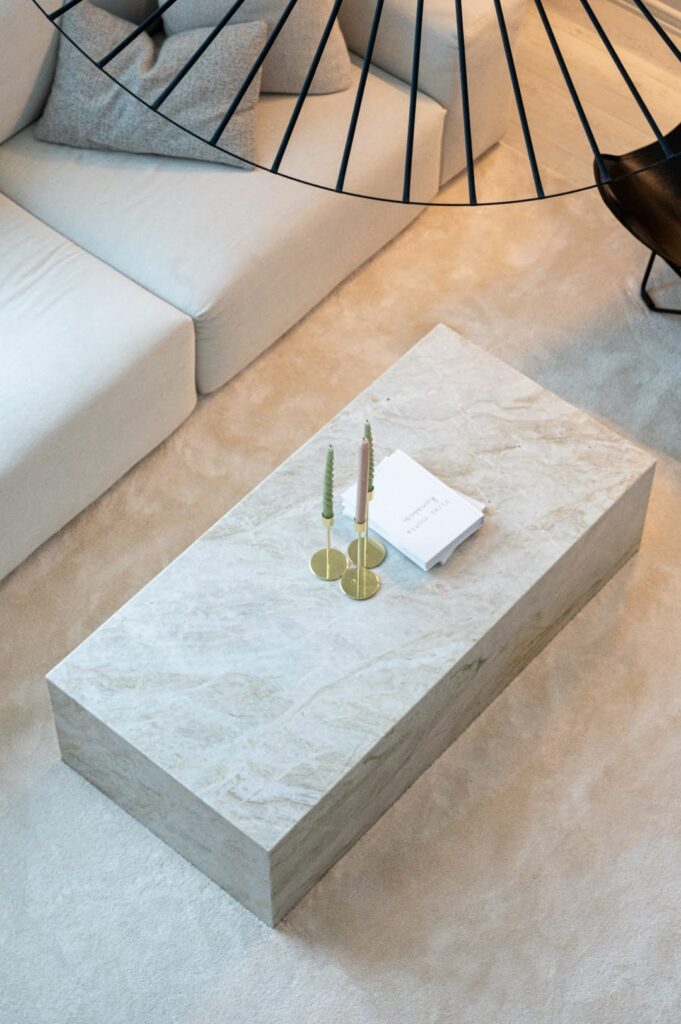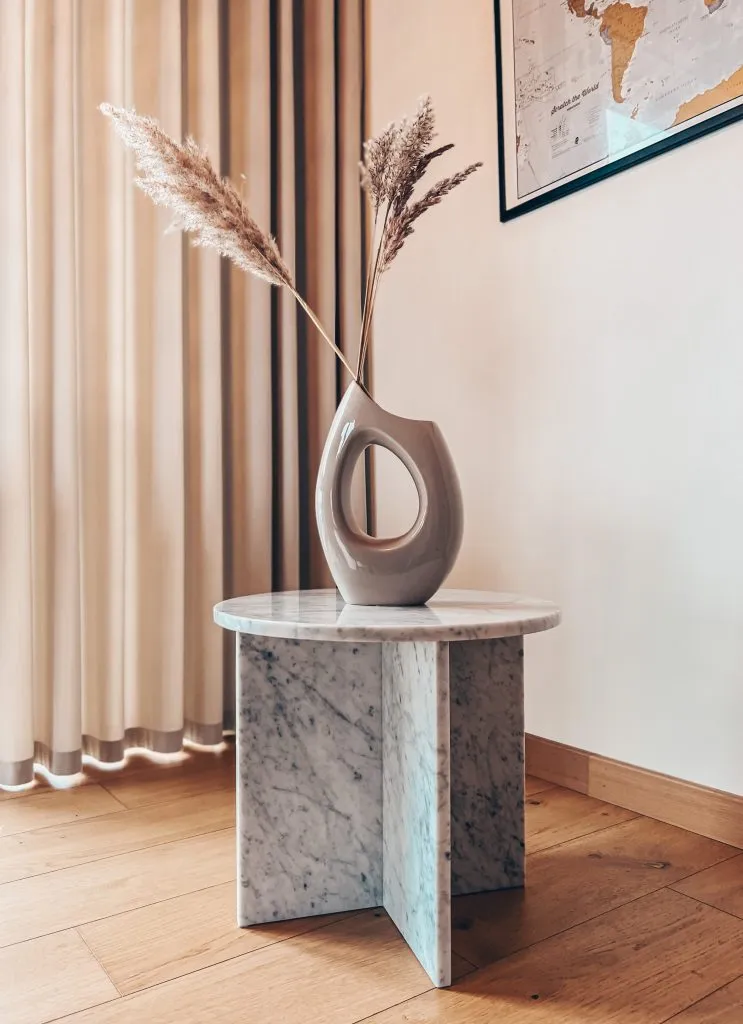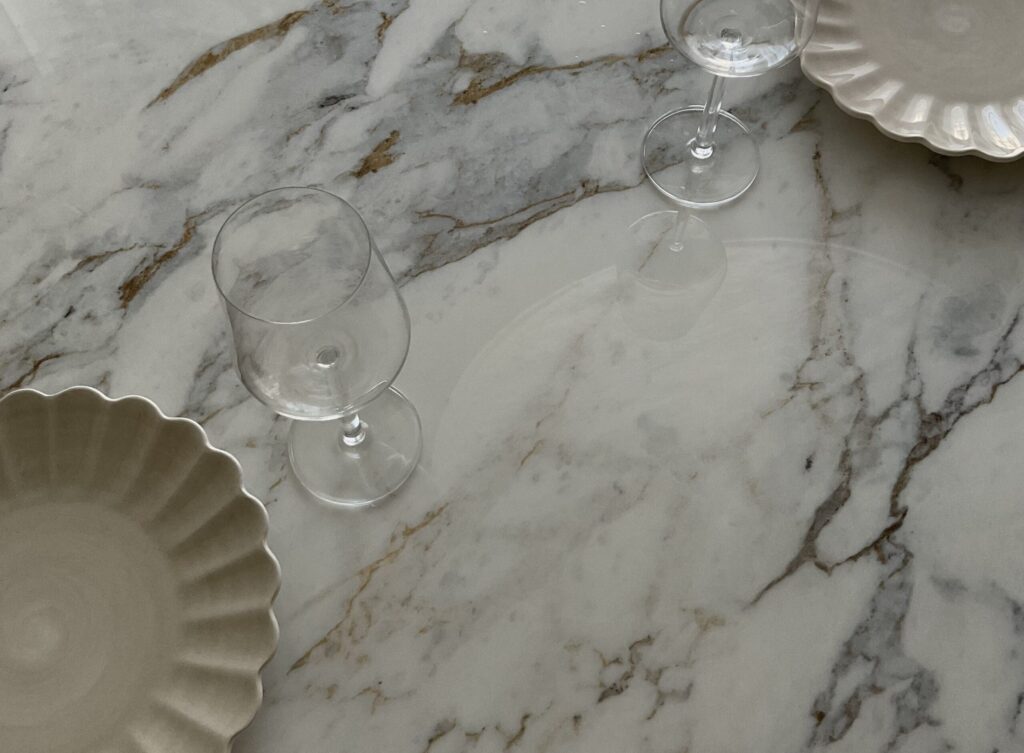Maintenance of materials
Stone is a luxurious and special material that needs to be taken care of properly. Here you can find instructions how to take care of your stone furniture so that it will stay beautiful as long as possible. Please read the instructions below and follow the advice.
For questions, please write to us on: info@thecorners.ee
Quartz stone is an industrially produced material that contains more than 90% natural ingredients and a smaller amount of other ingredients to maintain the correct color tone and consistency. To prepare the material, quartz is cut to the appropriate size and the edges and surface are processed. Quartz countertops are durable, waterproof, easy to maintain and last a very long time with proper maintenance.
Daily cleaning
For daily cleaning of the quartz surface, we recommend using a damp (microfibre) cloth, warm water and, if necessary, a neutral (pH 7), slightly alkaline (pH 8-10) or slightly acidic (pH 4-6) detergent. Those products that are specially designed for quartz stone should be preferred, and cleaning products that are highly acidic and contain bleaching agents should be avoided. The surface of the stone is sensitive to abrasive materials.
Stain prevention and removal
The quartz stone surface should be carefully protected from stains. Avoid contact of chemicals and caustics on the quartz surface. The best way to avoid stains is to remove the dirt immediately from the surface so that it cannot dry or absorb into the stone. Toilet paper, water and detergent should be enough for cleaning. To remove stronger stains, we recommend using special tools for quartz stone. After using the tool, we recommend washing the work surfaces again with water and detergent.
Avoiding heat damage and scratches
Quartz stone is not completely heat-resistant, it can withstand heat only for a short time and may crack as a result of thermal shock. Heat damage may remain on the work surface (e.g. a mark from the bottom of a hot food container) because the resin in the quartz stone starts to melt at high temperatures. For example, when placing hot objects on a surface containing mirror fragments. We do not recommend placing hot objects directly on these surfaces, even temporarily. Although quartz stone is quite scratch resistant, we still recommend always using cutting mats to avoid possible damage.
Long-term maintenance
Polished quartz surfaces do not require impregnation if they are used indoors, as quartz does not absorb liquids. The other surfaces with surface treatments also do not need impregnation in normal use.

Marble is a 100% natural material, featuring a unique color and pattern. The Marble surface is crafted from marble blocks extracted from the earth’s crust, which is then cut to the appropriate size and processed for a refined finish. While marble countertops are durable, they require proper and regular maintenance to preserve their beauty.
Daily cleaning
For everyday cleaning, we recommend using a damp microfiber cloth with warm water. If necessary, a neutral (pH 7) or slightly alkaline (pH 8-10) cleaner can be used. It is best to choose products specifically designed for natural stone, while avoiding cleaning agents that contain acids or bleach. Additionally, marble surfaces are sensitive to abrasives—using a wire sponge or encountering stray grains of sand on a washcloth can cause micro-damage.
Stain prevention and removal
Marble is a porous and highly absorbent material, requiring careful handling to prevent staining. Avoid exposing marble surfaces to harsh chemicals or caustic and acidic substances. Everyday items such as coffee, tea, oils, and acidic fruits should be handled with care.
To prevent stains from setting, clean spills immediately using paper towels, water, and a mild detergent. If stains are more stubborn, we recommend using specialized marble cleaning products. After applying the cleaning solution, rinse the surface thoroughly with water and detergent.
Avoiding heat damage and scratches
Since marble is softer and more porous than engineered stone, it is more prone to scratches. To prevent damage, always use coasters under plates and glasses. Additionally, when placing hot dishes/candles on a marble surface, we recommend using hot plates or coasters to protect against thermal damage.
Long-term maintenance
Depending on the level of use and the type of marble, we recommend re-treatment at least once a year with a special impregnation agent for marble.
- We always recommend using coasters under the plates/glasses.
- Avoid direct contact of sharp and hot objects with the surface of the stone.
- Pieces may break from the edges of the stone as a result of a forceful impact.
- In case of stains, remove them immediately, before the stone can absorb it!
- For cleaning, we recommend a damp microfiber cloth, warm water and a neutral, alcohol-free cleaning agent.
- The stone can be maintained from time to time with a special stone oil or wax, which reduces porosity and makes the surface of the stone more durable.

Ceramic is an industrially produced material that is stain and heat resistant. Ceramics with a matte and soft touch finish are also scratch resistant. In rare cases, delicate scratches may remain on the polished surface.
- For daily cleaning, we recommend using a damp microfibre cloth, warm water and a neutral general cleaner.
- Pieces may break from the edges of the stone as a result of a forceful impact.
- We recommend using pads under sharp and hot objects.
Granite is a natural material, but it is still very strong and has good and durable properties.
- For daily cleaning, we recommend using a damp microfiber cloth, warm water and a neutral, alcohol-free cleaning agent.
- We recommend using pads under sharp and hot objects.

